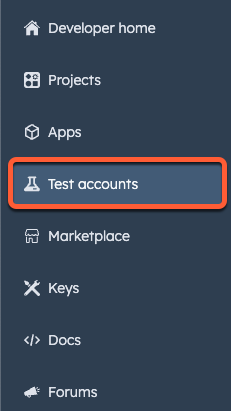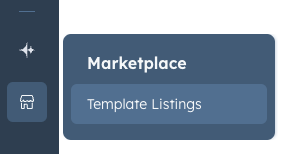Last modified: September 3, 2025
There are several types of HubSpot accounts, each with a distinct purpose. Below, learn about each account type.
Standard HubSpot accounts
A standard HubSpot account is the most common type of account. It’s where you’ll find all the tools, features, and settings included with your HubSpot plan. It can be free or paid, and is used as your production environment. A standard HubSpot account will have access to all the tools and features included with your plan.Developer accounts
Developer accounts are free accounts intended for creating and managing apps, integrations, and developer test accounts. They’re also where you can create and manage App Marketplace listings. Developer accounts and their associated test accounts aren’t connected to a standard HubSpot account, and they can’t sync data or assets with another HubSpot account. Get started by creating a developer account.Developer test accounts
Within developer accounts, you can create up to 10 test accounts to test apps and integrations without affecting any real HubSpot data. Developer test accounts are free HubSpot accounts with access to a 90-day trial of many enterprise features, with the following limitations:Limits
- Marketing Hub: you can only send marketing emails to addresses of users who you’ve added to your developer test account.
- Content Hub: the number of pages you can create are subject to the following limits:
- Website pages: 25
- Blogging tools: 1 blog with up to 100 posts
- Landing pages: 25
- Workflows: a maximum of 100,000 records can be enrolled per day in workflows created in a developer test account. If this daily limit is reached:
- Any additional attempted enrollment beyond this limit will be dropped.
- Users will be informed in app that they reached the daily record enrollment limit, as well as what time the limit will be refreshed.
Create a developer test account
To create a developer test account:- In the main navigation of your developer account, click Test accounts.

- In the upper right, click Create developer test account.

- Enter an account name, then click Create.
- In the main navigation of your developer account, click Test accounts.
- Click the name of the account to enter the account.
- To delete the account or renew its product trial periods, click Actions, then select Renew trials or Delete.
Sandbox accounts
Sandbox accounts allow you to test out changes without impacting your standard account. Learn more about the different types of sandbox accounts in the sections below.Standard sandbox accounts
If you have an Enterprise subscription, you can create a standard sandbox account that provides a safe and secure environment where you can test new workflows, integrations, website pages, and other important changes without impacting anything in your standard account. These sandboxes copy the structure of your standard account. A banner will be displayed at the top of your sandbox to indicate that you are in a sandbox portal. You can use the account picker to return to your production account. Learn more about standard sandbox accounts on HubSpot’s Knowledge Base.CMS sandbox accounts
CMS sandboxes are free accounts intended for building and testing website changes without impacting your standard account or live website. Similar to developer accounts, CMS sandbox accounts are not connected to your standard HubSpot account. You can create a CMS sandbox account for free. CMS sandboxes don’t have a banner, but they only have access to HubSpot’s free tools and CMS Hub Enterprise, minus the ability to connect a domain.Development sandbox accounts
If you have an Enterprise subscription, you can create a development sandbox account through the CLI for local development. A banner will appear at the top of your sandbox to indicate that you are in a sandbox account. You can use the account picker to return to your production account. Development sandbox accounts can only be managed via the HubSpot CLI. Check out the available commands in this reference article.Marketplace provider accounts
Marketplace Provider accounts are intended for creating and managing Template Marketplace listings and transactions. To get started selling on the Template Marketplace, create a Template Marketplace provider account. If you’re a HubSpot Partner, you already have Marketplace Provider functionality in your Partner account. A Marketplace Provider account can be identified by a Marketplace menu item in the main navigation bar.